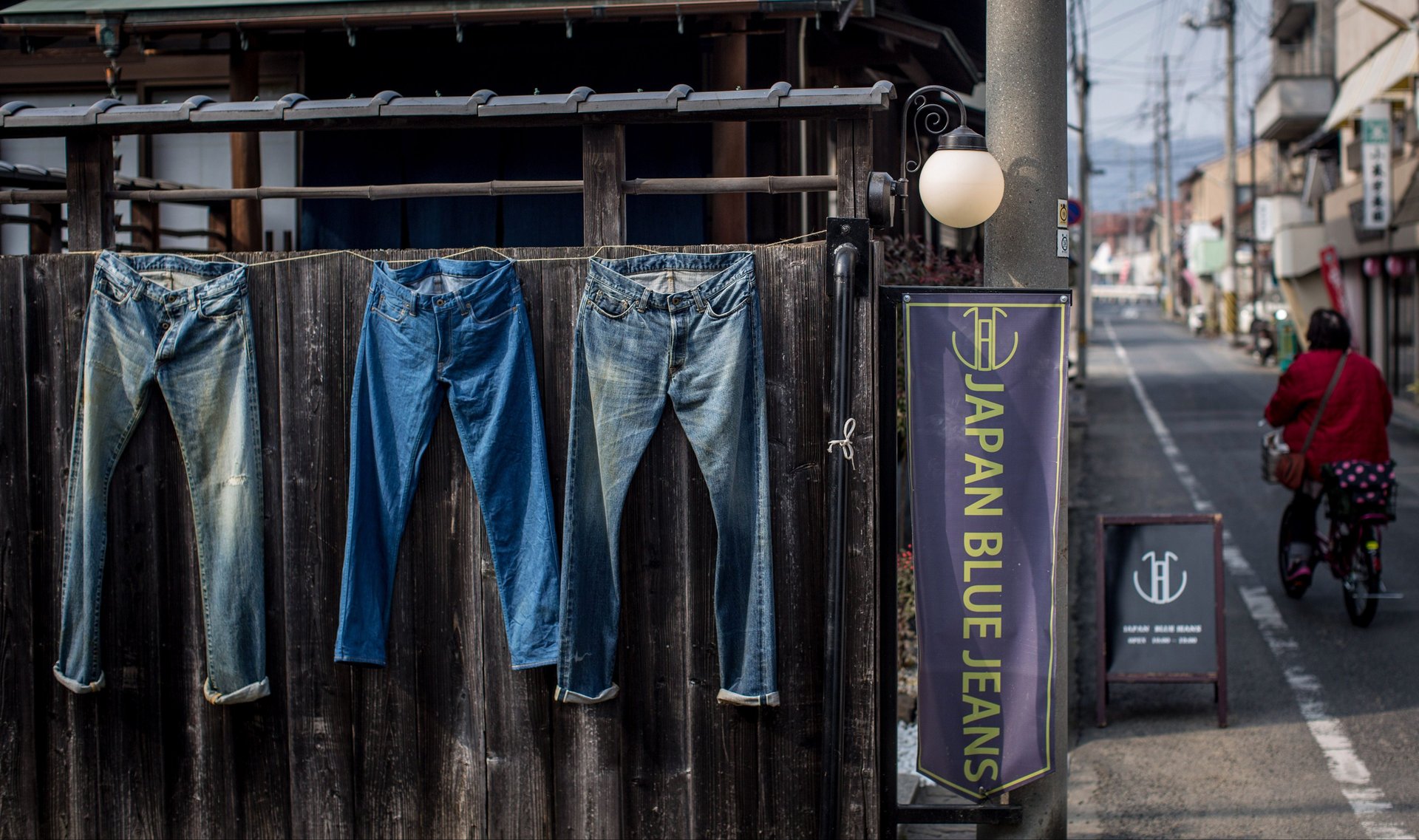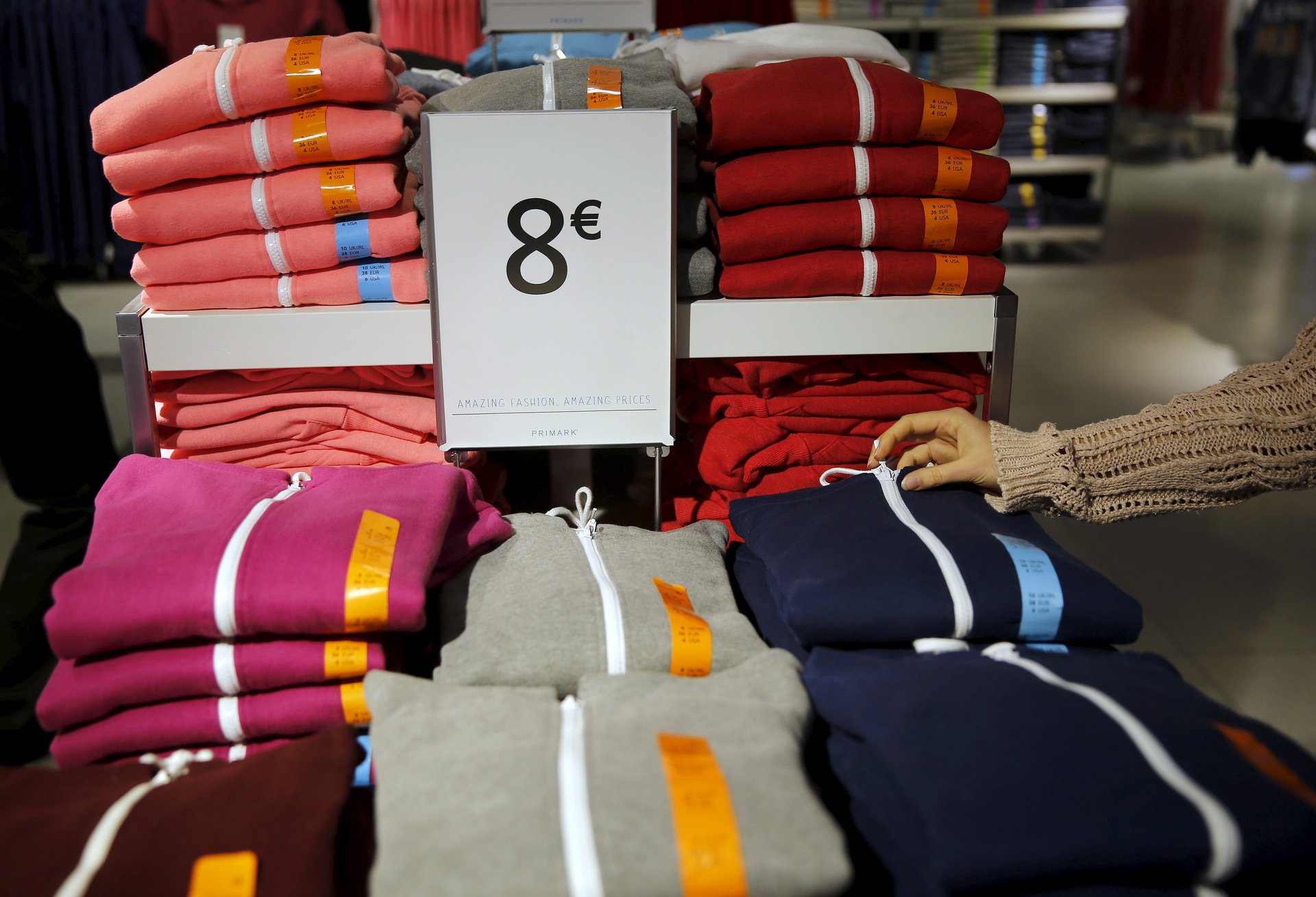In a disposable age, luxury is something old, worn, and beautiful
It’s not fun to wear old-fashioned, 100% cotton denim in its “raw” unwashed state. It’s stiff, like cardboard. It tends to crease rather than fold. It’s constricting and rough against the skin.


It’s not fun to wear old-fashioned, 100% cotton denim in its “raw” unwashed state. It’s stiff, like cardboard. It tends to crease rather than fold. It’s constricting and rough against the skin.
Most of the jeans you’ll find in stores today weren’t worn in for decades before softening into their current form. They’re washed to lighten the shade and relax the fabric, which is now often made with synthetic stretch materials to be more comfortable (or less expensive), and comes pre-distressed with wear marks you no longer make yourself.
The biggest difference between these two types of jeans, however, may not be how they look and feel right off the hanger: It’s how they look and feel after they’ve been worn and washed countless times.
In a year, the raw jeans will likely be better than when you bought them. But cheap, stretchy, pre-distressed pairs will often be best when you first bring them home from the store, and decline from there. When those raw jeans get a hole, you may actually want to patch them up and keep wearing them. When the other jeans start to rip, you’re more likely to toss them and get a new pair.
In the majority of clothing stores today, you’ll see racks overstuffed with clothes that are similarly at their prime when new, from cashmere sweaters to simple cotton t-shirts. They look and feel good when you cut the tags off, but many begin to lose their vibrancy or shape as you continually use and wash them. They’re not the sort of thing you want to keep repairing and wearing.
Clothes are a prime example of how our relationship to material goods is changing. In the past, we didn’t have the same abundance of cheap stuff staring back at us in stores or on our smartphones. When something broke, we may have had no choice but to fix it. That’s generally no longer the case in rich countries: It’s easier than ever to toss out old things and buy new ones, an approach manufacturers are happy to cater to, as it keeps their sales flowing.
This lifestyle may be convenient, but it’s terrible for the environment. And it’s also terrible for us.
It leads us away from buying things that can actually get better over time. Garments made from high-quality materials—especially natural ones, including cotton, cashmere, leather, and linen—often improve as you break them in. They soften and mold to your body and develop subtle imperfections that lend them a beauty and emotional charge that only comes with time and wear. It makes those items feel special and alive.
Easy come, easy go
While there wasn’t necessarily some magical time in the past when all clothing had this quality, thanks to the rise of fast fashion, it feels like it’s on the verge of disappearing all together. In many wealthy countries, clothes have become practically disposable. Between 2000 and 2014, global clothing production roughly doubled, but the average number of times a person wore a garment before discarding it steadily fell. This trend has been key to the growth of fast fashion. In an examination of how other businesses could emulate Zara’s phenomenal success, Harvard Business Review noted that some of its key practices can only apply “in high-tech or other industries where product life cycles are very short.”

At the same time, clothing has become progressively cheaper relative to other products. High price is never a guarantee of high quality, but cheapness can indicate low quality. Inexpensive cashmere is often low-grade material that’s been heavily washed to feel soft, but it pills and wears quickly. According to Timo Rissanen, co-author of Zero Waste Fashion Design and an assistant professor of fashion design and sustainability at Parsons School of Design in New York, manufacturers may also treat fabrics such as cotton so they feel substantial and smooth on the hanger, but once the chemicals wash out the low quality of the material is evident.
To save money, brands will also use thinner fabrics or synthetic blends. But the less dense a fabric, the less durable it typically is, and while synthetic blends do tend to hold color better over time, they often don’t do as well with repeated laundering. In the dryer under high heat, synthetic fibers can distort and lose their structure, and they shrink at different rates than natural fibers. That’s why a garment made of a synthetic blend can lose its shape over time.
Standard operating procedure today is to buy cheap and replace often, rather than invest and repair. In her 2012 book, Overdressed: The Shockingly High Cost of Cheap Fashion, Elizabeth Cline says the change is evident in US thrift shops, where clothing that has survived decades of wear sits beside more recent castoffs. “I can tell you that the quality coming through the donation stream has been trending down,” John Paben, co-owner of a processor of used clothes called Mid-West Textile, told her.
Shoes are in a similar predicament. Sneakers with foam soles were never really built to age well. But even dress shoes today often have soles constructed with materials such as plastic or paper mixed with fiberglass, rather than durable stacked leather. Their soles are glued on and can’t be repaired in the same way a pair of old-fashioned Goodyear-welted shoes can be. They’re essentially designed to be thrown away.
The things we wear aren’t the only place where you can see this trend, either. It turns up in modern objects of all sorts, such as home decor and furniture. IKEA has been pleading with consumers to stop tossing away their IKEA furniture, saying it should be recycled or repaired. Consumers, however, view their products as cheap and disposable.
The raw-denim revival
Denim is a great example of a material that ages gracefully when the quality is good. The cotton softens and conforms to the wearer as it slowly breaks in, and the threads are dyed in such a way that the outer layer of indigo wears off to reveal a white core, creating denim’s signature fades. It also happens to be one prominent category around which a small but devoted community—mostly men—has come together in appreciation of its assorted marks of age.
In the late 2000s and into this decade, interest in raw selvedge jeans made from Japanese denim surged in the US. To explain the terminology, ”raw” just means denim in its state when it’s first born, before it’s been washed and is still crisp and rigid. “Selvedge” refers to any fabric with edges that have been finished on the loom, creating a distinctive “self-edge” that doesn’t unravel. (But with regard to denim, it commonly means the fabric was woven on a narrow shuttle loom.) This method requires more cotton and time to create the fabric, but generally results in a denser, tougher material—one that also wears better over time.
Decades earlier, the big US denim makers had abandoned these looms and switched to faster, more efficient methods and dyeing processes. But when Japanese shoppers started scooping up American jeans in the 1980s, they didn’t want to settle for the new looms’ poorer quality. At the time, emulating American style was fashionable, so buyers were going to extraordinary lengths to find genuine American jeans from the 1950s, buying up all they could find at US thrift shops and importing them back to Japan. America’s new approach to denim, meanwhile, held little appeal.
“The famed traditional Levi’s 501, Lee 200, and Wrangler 13MWZ have changed quite a bit in terms of quality,” a Japanese jeans guide from the late 1980s stated, as W. David Marx recounts in his book, Ametora: How Japan saved American style. “For example, they are economizing on the dyeing process and using cheaper open-end spinning. They successfully increased manufacturing efficiency but have seen a decrease in quality. More was lost than was gained.”
Eventually, Japanese denim fanatics started making their own products. They used vintage American jeans as their inspiration, but improved on the fabrics, laboring over every detail, from the cotton to the indigo used. As North American audiences started recognizing the value of Japanese denim, brands appeared in the US and Canada that boasted of using Japanese fabric or producing in Japanese factories. They also looked to Cone Denim’s White Oak plant in North Carolina; the historic mill that had long supplied Levi’s and was the lone American holdout still producing selvedge denim.
Shops such as Blue in Green in New York and Self Edge in San Francisco were introducing guys to premium Japanese jeans, while raw selvedge jeans from labels such as APC and Dior Homme became staples among fashion-focused men. They obsessed over how long to wear their jeans before washing them to get the best fades. They shared knowledge and tips online in forums such as Superfuture and Styleforum: which brands used the best cotton, how to size jeans so they would stretch out just right with wear, and, as a last resort, washing methods. (Incidentally, don’t freeze your jeans or walk into the ocean wearing them; just wash them when they get dirty.) Selvedge denim even appeared in shops such as Gap and J.Crew.
But this kind of denim is ultimately an expensive niche product, fighting against a powerful tide of brands and their customers, who both prioritize cost and efficiency. A pair of raw selvedge jeans rarely costs less than $150 (and could reach to more than twice that), versus spending $60 or so at many mass-market shops.
In a signal of this shift, after more than a century in operation, the White Oak mill closed its doors at the end of 2017. According to its owner, International Textile Group, there wasn’t enough demand for its fabric.
What’s the appeal of looking worn-in?
“It’s just the idea that something’s been used to its ultimate purpose, that it’s being most efficiently consumed. To say it kind of wonkily, that it was loved and personalized and is a reflection of the person who put that time and effort and wear into it,” says David Shuck, managing editor of the website Heddels.
Growing out of the online frenzy about raw denim in the late 2000s, the site launched in 2011 as a repository of knowledge about the material. (Its name at the time was Rawr Denim, though it was renamed in 2015.) Since then, it has broadened its focus to things “you’ll want to use forever,” such as French press coffee makers, loopwheeled sweatshirts, and a variety of leather goods. According to Shuck, the editors at Heddels recognized that the things they loved about raw denim existed in other objects as well. One of the most important of those qualities is that the item, whatever it is, changes over time and improves with age.
It isn’t easy for Shuck to put into words what’s so attractive about this trait. He explains there’s a ghost imprinted on these objects that suggests their history. “The Japanese term for it, I’m sure you’ve heard, is wabi sabi,” he says.
In Japanese aesthetics, wabi sabi is a concept that ties back to the Buddhist notion of all things being in a constant state of flux. It’s notoriously difficult to define, and arguably beyond translation, though Andrew Juniper gives his personal interpretation in his book, Wabi Sabi: The Japanese Art of Impermanence:
Wabi sabi is an intuitive appreciation of a transient beauty in the physical world that reflects the irreversible flow of life in the spiritual world. It is an understated beauty that exists in the modest, rustic, imperfect, or even decayed, an aesthetic sensibility that finds a melancholic beauty in the impermanence of all things.
It isn’t present in everything old. Shiny, ornate, uniform materials don’t generally fit the concept, even if they are well-aged. (You might not see a lot of what you could call wabi sabi at the Palace of Versailles, for instance.) Neither is it visible in things that look worse for their wear, such as clothes that have become overly stretched out, or bear assorted food stains. It comes through most clearly in items that adhere to certain design principles Juniper identifies, including that they’re made of materials “whose devolution is expressive and attractive.”
These qualities risk being lost as clothing steadily shifts from long-lasting to replaceable. Our closets are increasingly filling up with synthetic materials, and these fabrics don’t tend to look better over time. They can develop a flat, lusterless look, and aren’t always the easiest to repair when damaged. Shuck points out, for instance, that it’s easier to fix a tear in a waxed cotton Barbour jacket than a Gore-tex jacket, even if Gore-tex otherwise serves its purpose well. “And the Barbour one might honestly look better with a few patches on it, rather than a tattered piece of nylon,” he adds.
There are some vocal proponents today for design that improves with age. Paola Antonelli, senior curator and director of research and development at New York’s Museum of Modern Art, has an upcoming exhibit in Milan called “Broken Nature” that promotes the idea. Rabih Hage, a London-based architect and designer, advocates an approach he calls “rough luxe.” The concept is to deliberately allow a space to show its age, and juxtapose the new and old within it. “You design with how people will evolve in space and how the place will age,” he told Quartz’s Anne Quito earlier this year.

According to Hage, the look can’t be fabricated through artificial wear and tear. “It’s about authenticity and experience,” he explained.
It raises an intriguing point in relation to denim: Can pre-distressed jeans be authentic? Denim is probably among the most artificially aged products that exists. In the 1980s, washing and distressing (referred to as finishing) became common across the denim industry. “The purpose behind finishing was to give denim a softer hand, or feel, and to make garments appear much older (or at least more worn) than they actually were,” writes Emma McClendon, a curator at the museum at New York’s Fashion Institute of Technology, in Denim: Fashion’s Frontier.
As fashion consumers, we already love the look of aged fabric. We just want someone else to create it for us—we want to buy our jeans with the wabi sabi already built in.
Levi’s devotes considerable time and resources to replicating wear and tear. They’re now using lasers to do it, and just based on appearance, the results are extremely difficult to tell apart from actual vintage jeans. Small artisanal Japanese labels, such as PRPS, Kapital, and 45rpm have built businesses on their artful reproductions of authentic-looking wear.
Our need for the new
Part of the reason we accept the low quality of a lot of clothing we buy today is because, ultimately, it doesn’t matter much. As Shuck points out, shoppers tend to get bored of clothes and discard them long before they can wear out. This problem isn’t strictly a modern one, but it becomes more common as the fashion cycle speeds up and we buy (and get rid of) more clothing.
Environmentally speaking, this high-volume production of clothes and other goods is awful. It consumes huge amounts of resources, such as water, and the end result is a deluge of quickly worn-out stuff flowing into landfills. Often we’re only shopping for the sake of shopping, and the item we’re buying is practically an incidental part of a greater urge. As objects become disposable, they lose their value.
This last point is the most important. We live surrounded by material culture; it’s a significant part of the capitalist way of life. But if it’s stripped of meaning, the loss isn’t to our things. They have no feelings. It’s to us.
As humans, we tend to prize objects we see as beautiful and meaningful, and we often recognize both of those qualities in cared-for items that wear the marks of time passing. It takes time and effort to imbue the things we love with those qualities. But they’re richer for it, and when we appreciate it, we are too.